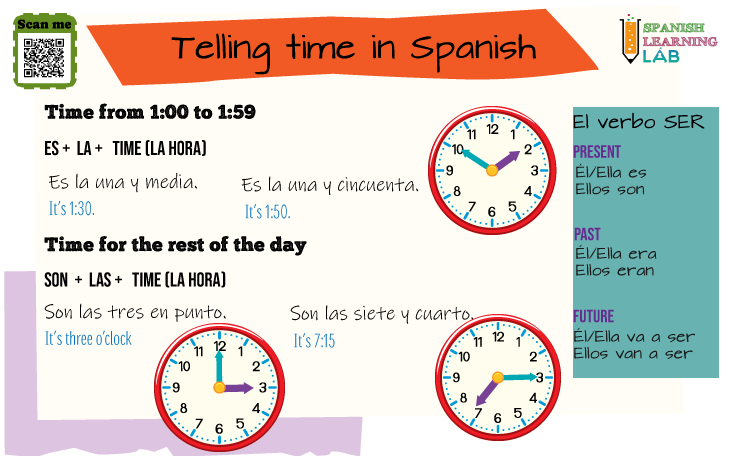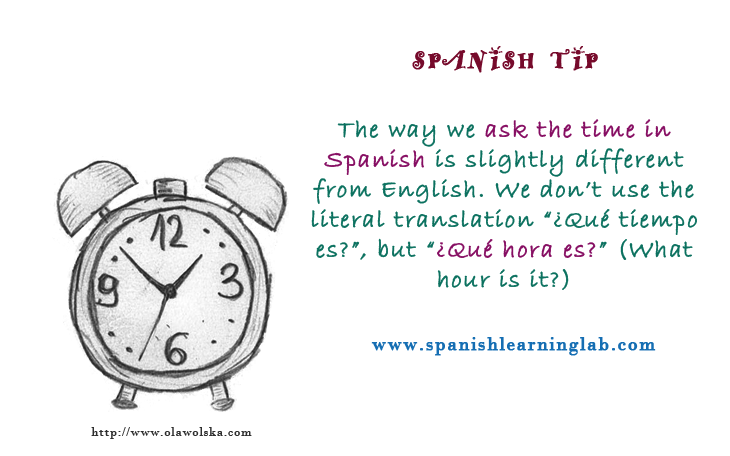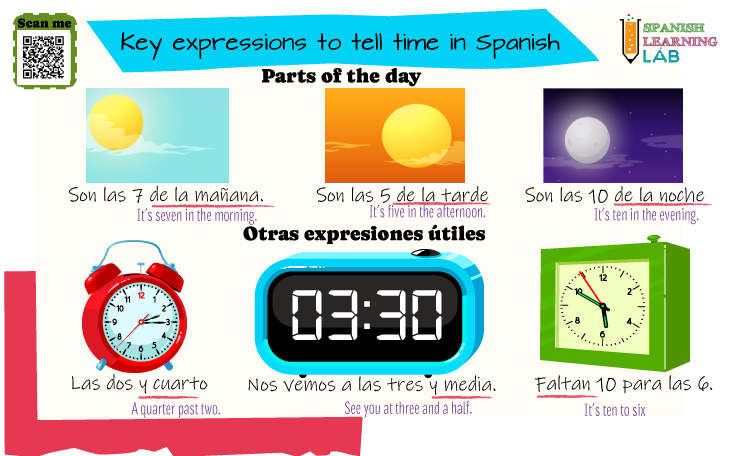Asking and telling time in Spanish may very useful in everyday conversations. This lesson will teach you the rules behind the most important questions to ask time in Spanish and the sentence structure to tell time in Spanish properly. We will also cover some expressions that are often used when telling time in Spanish. Hopefully, you will find the audio examples and explanations in this lesson very useful. Let’s start…
The sentence structure for telling time in Spanish – Diciendo la hora
In order to tell time in Spanish in the present tense, we will always use one of the two forms of the irregular verb SER (to be): ES and SON. The form ES will only be needed for telling the time between 1:00 to 1:59, whereas SON will be used for the rest of the day. With that said, if you meant to say “It is 1:30”, then you would have to tell time using ES like this: “Es la una y media”. On the other hand, when telling time in Spanish after 2:00, like “It is 2:30”, you would have to use SON like this: “Son las dos y treinta”. Most of the time, these type of sentences will begin with the verb SER plus a definite article and then the time, for example:

For telling time in Spanish in the past tense, we have to use the past forms of both ES and SON, that is “ERA” and “ERAN”, for example: “Era la una y cuarenta” (It was 1:40) and “Eran las 7 de la noche”. For talking about future time, we tend to use the phrase “Va(n) a ser + time in Spanish” (It is going to be…) this way: “Va a ser la 1:30” or “Van a ser las doce”.
Common Questions for asking time in Spanish – ¿Qué hora es?
The most common and easiest way for asking time in Spanish is “¿Qué hora es?” This question means “What time is it?” in Spanish, but it is not a literal translation as we use the word HORA instead of TIEMPO. We may ask differently depending on the formality of the conversation. A more formal way for asking time in Spanish would be by adding the expression DISCULPE or DISCULPA as in “Disculpe, ¿Qué hora es?“. This way, ff you need to ask time in Spanish, especially to a stranger, it is better to use a polite question like Disculpe ¿me puede decir la hora? or Disculpe ¿qué hora es?

Other ways for asking time in Spanish include “¿Qué tiempo/hora tienes?” (informal) and ¿Me puede decir la hora? (Can you tell me the time?). In the examples below, you will notice that the answers will use the verb SER as “ES” and “SON” to tell time. One of the examples shows that for time expressions like “It’s 10 to 12”, we must use the verb “FALTAR” (to lack) instead of “SER”. With that said, the correct sentence would be “Faltan 10 para las 12” instead of “Son las 10 para 12” (wrong literal translation). Pay attention to these examples and listen to their pronunciation:
|
¿Qué hora es? – Son las ocho en punto
What time is it? – It´s 8 o´clock
|
|
¿Qué hora es? – Faltan diez para las dos
What time is it? – It’s 10 to 2
|
|
¿Qué hora es? – Son las cuatro y veinticinco.
What time is it? – It´s 4:25
|
|
¿Qué hora es? – Es la una y treinta/ Es la una y media
What time is it? – It´s 1:30
|
|
Disculpe, ¿me puede decir la hora? – Son las ocho y cinco
Excuse me, can you tell me what time
|
How to ask “At what time” in Spanish
In order to ask “at what time” in Spanish, we should modify the question “¿Qué hora es?” a little bit by adding the preposition “A” at the beginning as in “¿A qué hora…?” (What time do…). This way, you can ask things like: ¿A qué hora nos vamos? (what time are we leaving?) and ¿A qué hora te levantas? (What time do you get up?). The answer may be the estimated or exact time in Spanish, for example: “Nos vamos en unos 30 minutos” (We are leaving in about 30 minutes) and “Yo me levanto a las 8 de la mañana” (I get up at 8 o´clock). Listen to these two examples:
|
¿Cuánto tiempo te lleva/toma limpiar tu casa?
How long does it take you to clean your house?
|
|
¿A qué hora te vas?
What time are you leaving?
|
Useful expressions for telling time in Spanish
Now we will talk about some very useful expressions for telling time in Spanish that always come handy in different situations.
“UN CUARTO PARA” (a quarter to) – this phrase is often placed after the verb FALTAR (to lack/to be left) in the structure:
Falta/Faltan + time left + para la/las + hour
e.g. Falta un cuarto para las diez (it’s a quarter to ten )
“MEDIA” (a half) – this will be used often following the structure above too: “Falta media hora para la una” (It’s a half hour to 1:00) or in a more simplified way “Es la una y media”.

Remember that the definite article LA will be used for time between 1:00 and 1:59 as in “La una y cincuenta”, whereas LAS is for any other time in as in “Las tres y treinta”.
Last, you can use the expressions “por/de la mañana“, “por/de la tarde” and “por/de la noche” to talk about a particular part of the day. Listen to some examples using these and other phrases for talking about time in Spanish.
|
El programa comienza a las 7 de la mañana
The show starts at 7 in the morning.
|
|
Salimos del trabajo a las 2 de la tarde.
We get out of work at 2 in the afternoon
|
|
La fiesta comienza a las 10 de la noche.
The party starts at 10 at night.
|
|
Ayer fue un día ocupado
Yesterday was a busy day
|
|
Hoy es un buen día
Today is a good day
|
|
Mañana leeré (por) varias horas
Tomorrow I’ll read for several hours
|
|
Nos iremos en unos cuantos minutos
We will leave in some minutes
|
Interactive Quiz: Time in Spanish
This is all for now. We hope you learned a couple of new expressions or questions in this lesson. Make sure to practice telling time in Spanish by yourself to your friends. If you want to continue learning about this topic and work on your listening ability, please check the next lesson on this topic, which will cover short sample conversations and listening activities about time. ¡Hasta pronto!
Related Spanish Worksheets:
- Telling Time in Spanish – PDF Worksheet
- Daily Activities & Time in Spanish (Clocks)
- Dialogues about daily routines in Spanish
- Daily Activities and Time in Spanish (Timetable + Sentences)
- Practicing Telling Time in Spanish (Clocks + sentences)
